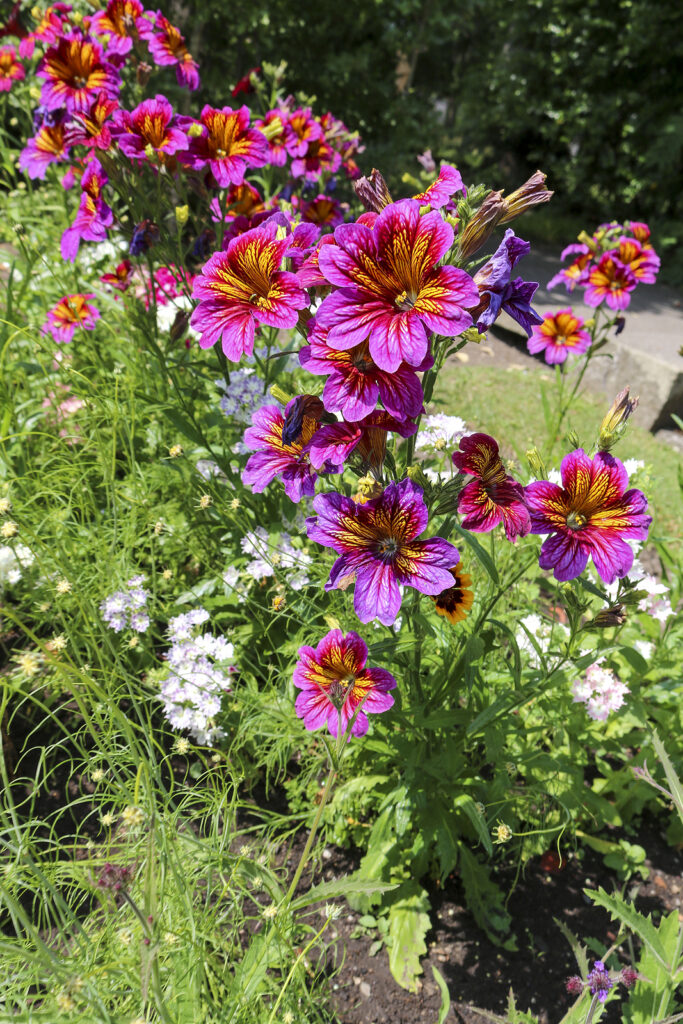Salpiglossis—commonly called painted tongue–is a cool-summer annual with colorful marbled or streaked flowers. Salpiglossis blooms come in shades of mahogany, red, reddish-orange, yellow, purple, and pink.
Salpiglossis is loose to densely branched with sticky leaves and stems. It grows 24 to 36 inches (61-91cm) tall.
Plant Salpiglossis as a border background plant or use it in mixed plantings and containers. It is an excellent cut flower.
There are only two species in the Salpiglossis genus. Salpiglossis is native to the Andes in Chile.
Garden Success Products at Amazon:
- 10 pcs Stainless Steel Garden Hand Tool Set
- Flexi Hose with 8-inch Nozzle
- Gorilla Cart 4 Cu. Ft, 300-pound Capacity
- Neem Bliss 100-% Cold Pressed Neem Oil
- Safer Brand Insect Killing Soap

Get to know Salpiglossis
- Plant type: Annual
- Growing zones and range: All zones a cool-summer annual
- Hardiness: Cool-weather annual
- Height and width: Upright, open habit grows 24 to 36 inches (61-91cm) tall
- Foliage: Sticky leaves and stems; leaves to 4 inches (10cm) narrowly oblong
- Flowers: Velvety-textured flowers much like petunias in shade and size; flowers to 2 inches (5cm) wide.
- Flower colors: Shades of mahogany, red, reddish-orange, yellow, purple, and pink tones, marbled and penciled with contrasting colors.
- Bloom time: Late spring and early summer
- Uses: Border background plant; used in mixed plantings and containers; excellent cut flowers.
- Common name: Painted tongue, velvet flower
- Botanical name: Salpiglossis sinuata
- Family name: Solanaceae
- Origin: Andes
Where to plant Salpiglossis
- Plant Salpiglossis in full sun.
- Grow Salpiglossis in average to humus-rich, well-drained soil.
- Plants grow best when summer is not excessively hot.
- Where summers are warm plant Salpiglossis where it will get light afternoon shade.
Salpiglossis uses
- Plant Salpiglossis in beds and borders; use it in the middle of borders or as a background plant. It is complemented by Gypsophila and Nigella.
- Cut flowers can be used in bouquets.
- Smaller cultivars can be used as bedding or in containers.
When to plant Salpiglossis
- Sow seeds indoors in individual pots 8 to 10 weeks before the last spring frost.
- Hardened-off seedlings can be moved to the garden 2 weeks before the last frost in spring.
- Sow seed outdoors just before the average last frost date.
- Where summer is hot, start plants early so they have time to bloom before warm weather arrives.

Planting and spacing Salpiglossis
- Sow seeds at 70° to 75°F (21°-24°C).
- Just press the tiny seeds into the soil surface; seeds need darkness to germinate so cover the seed lightly with soil or place black plastic over seed-starting pots.
- Germination takes 7 to 14 days.
- Mulch seedlings when they are several inches tall to keep roots cool.
How to water and feed Salpiglossis
- Keep the soil evenly moist.
- Add an all-purpose fertilizer to garden soil before setting Salpiglossis in the garden.
Salpiglossis care
- Stake tall plants to keep them from flopping.
- Pinch out tips of growing plants to induce branching.
- Regular deadheading will keep flowers blooming until frost.
Salpiglossis pests and diseases
- Soil-borne fungal diseases may cause wilt and dieback.
Salpiglossis propagation
- Sow seed outdoors in late winter or spring indoors.
- Seeds germinate in 7 to 10 days at 70° to 80°F (21°-27°C).
- Potted plants for indoors, can be sown in late summer for early spring flowering.
Salpiglossis varieties to grow
- Salpiglossis sinuata, painted tongue: erect, somewhat weak-stemmed annual grows 18 to 24 inches (45-61cm) tall; bears five-lobed flowers to 2 inches across from summer to fall; a full range of rich colors. There are several cultivars including a few dwarf cultivars.
Painted tongue–Salpiglossis frequently asked questions
Q: What conditions does a painted tongue plant like?
A: Salpiglossis–painted tongue–grows best where summers are moderate, in full, and humus-rich, well-drained soil. They must have a continuous supply of moisture.
Q: How do I propagate Salpiglossis?
A: Propagate Salpiglossis by seed. Sow seeds indoors 8 weeks before planting out. Set plants out after all danger of frost has passed. Seeds should be covered; they need darkness to germinate. Seeds germinate in 15 to 20 days at 70° to 75°F.
Q: How do I keep mature painted tongue plants upright?
A: Mature Salpiglossis has a tendency to lean or flop over. Locate them in the center of planting where they are protected from wind, Push brushwood into the ground around young plants; the foliage will hide the support as it grows.
Q: Where should I plant painted tongue in the flower garden?
A: Salpiglossis is ideal for the center of beds or borders. Place them at the center of container plant arrangements surrounded by lower-growing or trailing plants.
Related Articles:
- 20 Perennials That Bloom for 6 to 8 Weeks
- Shrubs with Showy Flowers Season-by-Season
- Trees in Garden Design
- Growing Annuals for Summer Bloom
- Trees—click here for more articles
- Shrubs—click here for more articles
- Perennials—click here to see more
- Annuals—click here to see more















